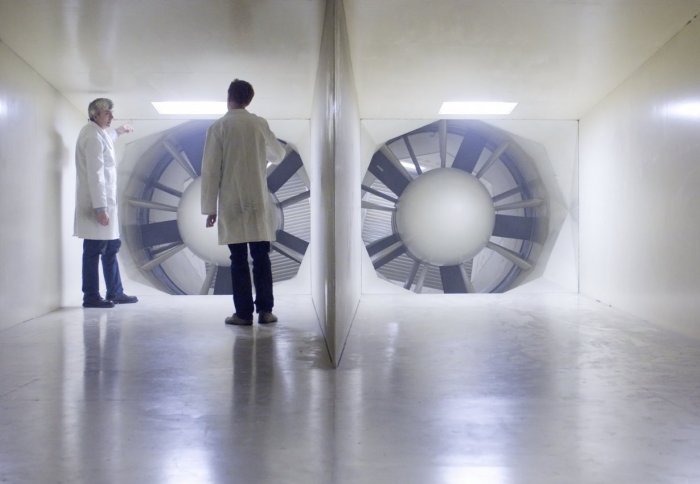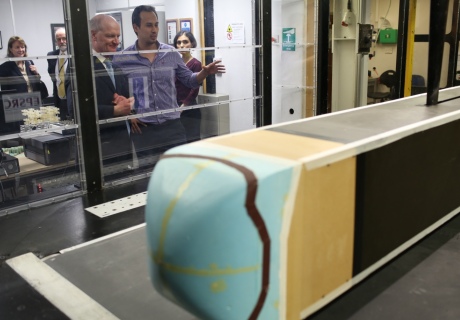Wind tunnel upgrades and more postgraduate opportunities announced today
by Colin Smith

Enhanced postgraduate training and improvements to the UK's world-leading wind tunnel facilities announced by Universities Minister.
During a visit to Imperial, Universities and Science Minister David Willetts announced funding for 19 more Centres for Doctoral Training (CDTs), including three based at Imperial. Their creation will boost postgraduate training in a wide range of engineering and scientific fields important to the UK’s economy including nuclear energy.

Mr Willetts learns more about lorry model designs being tested in the Honda Wind Tunnel
The Minister also announced funding for a National Wind Tunnel Facility, led by Imperial, aimed at keeping Britain at the forefront of experimental aerodynamics and fluids research.
Professor James Stirling, Provost of Imperial College London, says: “Securing a further three CDTs to add to the seven already awarded cements Imperial’s position as a leader in postgraduate education and research, helping to produce the next generation of scientists, engineers and industrialists who will drive the UK’s economic recovery. Imperial’s wind tunnels have historically played a pivotal role in the development of Formula One car design, with many of our graduates going on to important careers in the industry. New funding will help secure our global advantage in this field, fostering greater capacity and driving forward much needed research in a range of areas, from green energy to more fuel efficient aircraft.”
Mr Willetts said in regards to the National Wind Tunnel Facility:“This new investment will support research that is vital to the UK economy, including developing the next generation of fuel efficient heavy goods vehicles. This will create huge energy savings to businesses, as well as bringing environmental benefits. It is pioneering work that will help the UK get ahead in the global race.”
Professor David Delpy, Engineering and Physical Sciences Research Council Chief Executive, said: “This new national facility builds on our previous investments in aerodynamics and fluid dynamics related research and PhD training across the institutions involved. These represent a total research portfolio of over £37 million. The new CDTs will also provide training and advances in research in many areas of science and engineering including quantum technologies, manufacturing, robotics, energy and sustainability and brings the total number of centres funded in this round to ninety one.”
Dr Paul Nicholas Stavrinou from Imperial’s Department of Physics will lead the CDT in Plastic Electronic Materials. Professor Christopher Cheeseman, Department of Civil and Environmental Engineering, will lead the CDT in Sustainable Civil Engineering, and Professor Bill Lee, Department of Materials, will head the CDT in Nuclear Energy. Their creation now takes the total number of CDTs based at Imperial to ten, with a further six CDTs that the College is partnering in.
Mr Willetts also announced that Imperial and its partners, the Universities of Oxford, Cambridge, Southamption, Cranfield, Glasgow and City will receive £13.3 million to upgrade wind tunnel infrastructure, £4 million of which will go directly to the College.
For decades Imperial has been leading in this field and its Honda Wind Tunnel facility has been used by industry and academics to advance research in a range of areas from Formula One car design to the creation of better aircraft components.
The funds will be used by researchers at Imperial to position an array of lasers inside the wind tunnel to more accurately model airflow. For example researchers learning more about how heavy vehicles such as lorries are affected by drag, which affects fuel efficiency, will use the technology to capture airflow data simultaneously from multiple points, so that better vehicle designs can be developed.
Apart from the scientific and engineering gains that this technology will bring, the researchers also say that the instrumentation will speed up research in the wind tunnel, making it more cost and time effective for academics to use.
Professor Jonathan Morrison, from the Department of Aeronautics who leads Imperial’s wind tunnel facility, said: “The Government’s much needed investment in the nation’s leading wind tunnel facilities will have a transformative effect and drive innovation across a broad range of sectors in a variety of fields. At Imperial, this will help us, for instance, to design bridges that can better withstand wind induced vibrations and more efficient wind turbines, and to develop better aircraft wings that improve fuel efficiency.”
Article supporters
Article text (excluding photos or graphics) © Imperial College London.
Photos and graphics subject to third party copyright used with permission or © Imperial College London.
Reporter
Colin Smith
Communications and Public Affairs